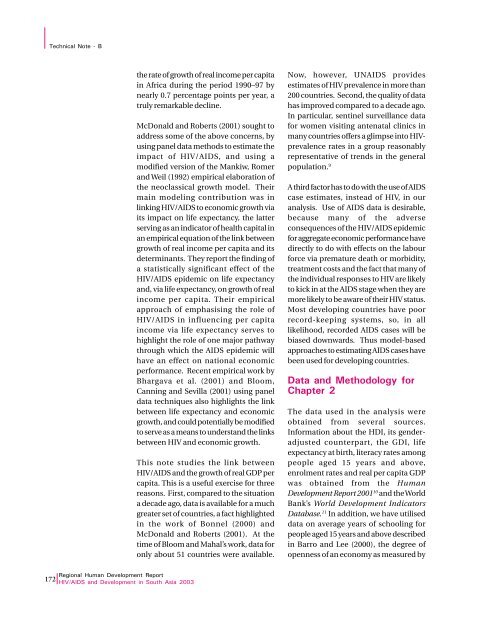Download Report - UNDP Asia-Pacific Regional Centre - United ...
Download Report - UNDP Asia-Pacific Regional Centre - United ...
Download Report - UNDP Asia-Pacific Regional Centre - United ...
You also want an ePaper? Increase the reach of your titles
YUMPU automatically turns print PDFs into web optimized ePapers that Google loves.
Technical Note - Bthe rate of growth of real income per capitain Africa during the period 1990–97 bynearly 0.7 percentage points per year, atruly remarkable decline.McDonald and Roberts (2001) sought toaddress some of the above concerns, byusing panel data methods to estimate theimpact of HIV/AIDS, and using amodified version of the Mankiw, Romerand Weil (1992) empirical elaboration ofthe neoclassical growth model. Theirmain modeling contribution was inlinking HIV/AIDS to economic growth viaits impact on life expectancy, the latterserving as an indicator of health capital inan empirical equation of the link betweengrowth of real income per capita and itsdeterminants. They report the finding ofa statistically significant effect of theHIV/AIDS epidemic on life expectancyand, via life expectancy, on growth of realincome per capita. Their empiricalapproach of emphasising the role ofHIV/AIDS in influencing per capitaincome via life expectancy serves tohighlight the role of one major pathwaythrough which the AIDS epidemic willhave an effect on national economicperformance. Recent empirical work byBhargava et al. (2001) and Bloom,Canning and Sevilla (2001) using paneldata techniques also highlights the linkbetween life expectancy and economicgrowth, and could potentially be modifiedto serve as a means to understand the linksbetween HIV and economic growth.This note studies the link betweenHIV/AIDS and the growth of real GDP percapita. This is a useful exercise for threereasons. First, compared to the situationa decade ago, data is available for a muchgreater set of countries, a fact highlightedin the work of Bonnel (2000) andMcDonald and Roberts (2001). At thetime of Bloom and Mahal’s work, data foronly about 51 countries were available.Now, however, UNAIDS providesestimates of HIV prevalence in more than200 countries. Second, the quality of datahas improved compared to a decade ago.In particular, sentinel surveillance datafor women visiting antenatal clinics inmany countries offers a glimpse into HIVprevalencerates in a group reasonablyrepresentative of trends in the generalpopulation. 9A third factor has to do with the use of AIDScase estimates, instead of HIV, in ouranalysis. Use of AIDS data is desirable,because many of the adverseconsequences of the HIV/AIDS epidemicfor aggregate economic performance havedirectly to do with effects on the labourforce via premature death or morbidity,treatment costs and the fact that many ofthe individual responses to HIV are likelyto kick in at the AIDS stage when they aremore likely to be aware of their HIV status.Most developing countries have poorrecord-keeping systems, so, in alllikelihood, recorded AIDS cases will bebiased downwards. Thus model-basedapproaches to estimating AIDS cases havebeen used for developing countries.Data and Methodology forChapter 2The data used in the analysis wereobtained from several sources.Information about the HDI, its genderadjustedcounterpart, the GDI, lifeexpectancy at birth, literacy rates amongpeople aged 15 years and above,enrolment rates and real per capita GDPwas obtained from the HumanDevelopment <strong>Report</strong> 2001 10 and the WorldBank’s World Development IndicatorsDatabase. 11 In addition, we have utiliseddata on average years of schooling forpeople aged 15 years and above describedin Barro and Lee (2000), the degree ofopenness of an economy as measured by<strong>Regional</strong> Human Development <strong>Report</strong>172 HIV/AIDS and Development in South <strong>Asia</strong> 2003
















